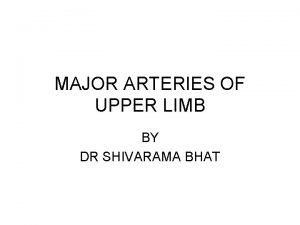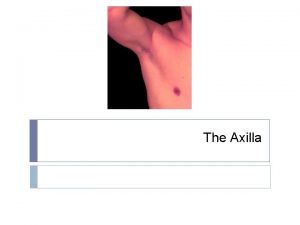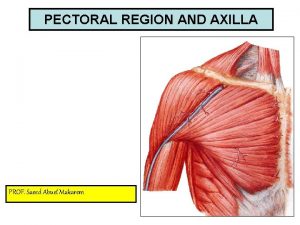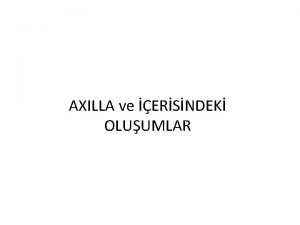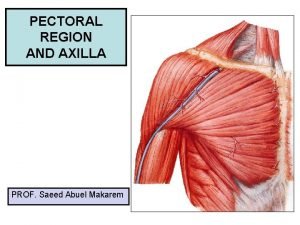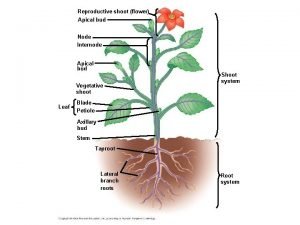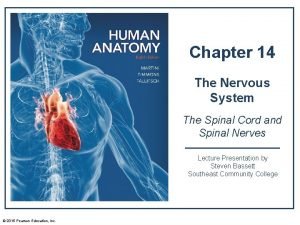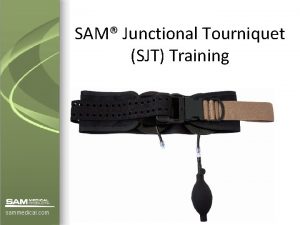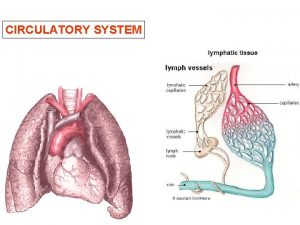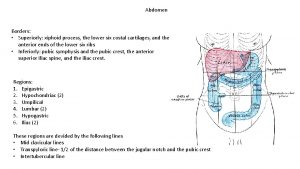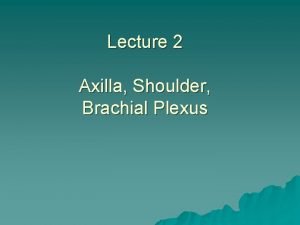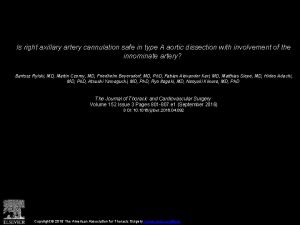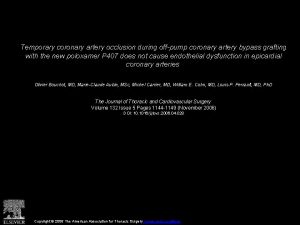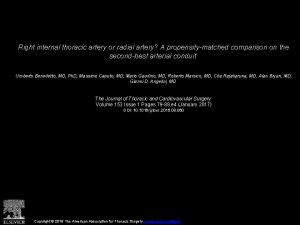Contents of the Axilla 1 Axillary artery and







































- Slides: 39


Contents of the Axilla 1. Axillary artery and its branches. 2. Axillary vein and its tributaries. 3. Cords of the brachial plexus and 4. 5. 6. their branches. Axillary lymph nodes and lymph vessels. Axillary tail of the mammary gland. Axillary fat.

1. Axillary Artery

It is the only artery which supplies the upper limb. Beginning: at the outer border of the first rib as a continuation of the subclavian artery. End: at the lower border of the teres major muscle, where it continues as the brachial artery. Course: – It is surrounded with cords and branches of brachial plexus inside the axillary sheath. – Pectoralis minor muscle passes in front of the artery and divides it into 3 parts.

Relations the First part Anteriorly: Skin, Fascia (superficial and deep), pectoralis major muscle and clavipectoral fascia. Posteriorly: 1 st intercostal space, 1 st digitation of serratus anterior, long thoracic nerve and medial cord of brachial plexus. Laterally: Lateral and posterior cords of the brachial plexus. Medially: Axillary vein.

Relations the Second part Anteriorly: Skin, Fascia (superficial and deep), pectoralis major and minor muscles. Posteriorly: Posterior cord of brachial plexus and subscapularis muscle. Laterally: Lateral cords of the brachial plexus and coraco-brachialis muscle. Medially: Medial cord of brachial plexus and axillary vein.

Relations the Third part Anteriorly: Skin, Fascia (superficial and deep), pectoralis major and medial root of median nerve. Posteriorly: Subscapularis, latissimus dorsi and teres major muscles, radial and axillary (circumflex) nerves. Laterally: Coraco-brachialis and biceps muscle, humerus, lateral root of median nerve and musculo-cutaneous nerve. Medially: Axillary vein, ulnar nerve and medial cutaneous nerves of arm and forearm.

Branches of the Axillary artery From 1 st part: 1. Highest (superior) thoracic artery. From 2 nd part: 2. Thoracoacromial artery. 3. Lateral thoracic artery. From 3 rd part: 4. Subscapular artery. 5. Anterior circumflex humeral artery. 6. Posterior circumflex humeral artery.

Highest thoracic artery ØIt is a branch of the 1 st part of axillary artery. ØIt runs along the upper border of pectoralis minor. ØIt supplies the pectoral muscles and thoracic wall.

Thoraco-acromial artery ØIt is a branch of the 2 nd part of axillary artery. ØIt is a short artery that pierces the clavipectoral fascia and divides into 4 branches (acromial, pectoral, clavicular and deltoid). ØIt supplies the pectoral region, thoracic wall and mammary gland.

Lateral thoracic artery ØIt is a branch of the 2 nd part of axillary artery. ØIt runs along the lower border of pectoralis minor. ØIt supplies the pectoral muscles, and thoracic wall. ØIn females, it is larger and gives lateral mammary branches.

Subscapular artery ØIt is a branch of the 3 rd part of axillary artery. ØIt is the largest branch of the axillary artery ØIt runs along the lower border of subscapularis muscle. ØIt gives off circumflex scapular branch. ØIt shares in anastomosis around the scapula.

Anterior circumflex humeral artery ØIt is a branch of the 3 rd part of axillary artery. ØIt is a small artery that runs laterally in front of the surgical neck of the humerus. ØIt anastomoses with the posterior circumflex humeral artery around the surgical neck of the humerus.

Posterior circumflex humeral artery Ø It is a branch of the 3 rd part of axillary artery. Ø It is larger than the anterior one and runs with the axillary nerve to enter the quadrangular muscular space. Ø Then it passes behind the surgical neck of the humerus. Ø It anastomoses with the anterior circumflex humeral artery around the surgical neck of the humerus.

2. Axillary Vein

Beginning (Formation): at the lower border of the teres major muscle, by union of the basilic vein with the venae comitantes of the brachial artery. End: at the outer border of the first rib where it continues as the subclavian vein. Course: It runs upward on the medial side of the axillary artery. Tributaries: 1. Veins correspond to branches of axillary artery. 2. Cephalic vein (near its termination).

3. Brachial Plexus

Definition: It is a network of nerves concerning with the nerve supply of upper limb. Origin: from the ventral rami of C 5, 6, 7, 8 +T 1. Composition and site: – Root: in the posterior triangle of the neck – Trunks: in the posterior triangle of the neck. – Divisions: behind the clavicle. – Cords: in the axilla (related to 1 st and 2 nd parts of axillary artery. – Branches: in the axilla (related to the 3 rd part of axillary artery).

Formation of the plexus

ROOTS Ø They are formed by the ventral rami of the 5 th, 6 th, 7 th, 8 th cervical and 1 st thoracic spinal nerves. Ø It may take origin from the 4 th cervical nerve (prefixied plexus), or from the 2 nd thoracic nerve (postfixed plexus). Ø They lye in the posterior triangle of the neck. Ø They unites together to form the trunks.

Trunks Ø They are formed by the roots of the plexus. Ø They are 3 (upper, middle and lower). Ø Upper trunk (C 5, 6) is formed by the union of the ventral rami of the 5 th and 6 th cervical nerves. Ø Middle trunk (C 7) is formed by the ventral ramus of the 7 th cervical nerve alone. Ø Lower trunk (C 8, T 1) is formed by the union of the ventral rami of 8 th cervical and 1 st thoracic nerves. Ø They lye in the posterior triangle of the neck. Ø Each trunk divides to give anterior and posterior division.

Divisions ØThey are formed from the trunks. ØThey are 6 in number (3 anterior and 3 posterior). ØThey lye behind the middle third of the clavicle (apex of the axilla). ØThe divisions unite to form the cords of the brachial plexus.

Cords Ø They are formed by union of the divisions of the plexus. Ø They are 3 (lateral, medial and posterior). Ø Lateral Cord (C 5, 6, 7) is formed by the union of the anterior divisions of the upper and middle trunks. Ø Medial Cord (C 8, T 1) is formed by the anterior division of the lower trunk alone. Ø Posterio Cord (C 5, 6, 7, 8, T 1) is formed by the union of the posterior divisions of the upper, middle and lower trunks. Ø They lye in the axilla (opposite 1 st and 2 nd parts of axillary artery). Ø Each cord gives off the braches of the plexus.

Relations of the Cords to the axillary artery Ø Lateral Cord: § Lateral to the 1 st and 2 nd parts of the artery. Ø Medial Cord: § Posterior to the 1 st part of the artery. § Medial to the 2 nd part of the artery Ø Posterio Cord: § Lateral to the 1 st part of the artery. § Posterior to the 2 nd part of the artery.

Branches of the brachial plexus

Branches of the Brachial plexus From the Roots: 1. Dorsal scapular nerve (C 5) supplies the levator scapulae and rhomboid muscles (major and minor). 2. Long thoracic nerve (C 5, 6, 7) descends superficial to the serratus anterior muscle which it supplies. From the trunks: 1. Nerve to subclavius (5, 6) which sometimes gives off accessory phrenic nerve (C 5). 2. Suprascapular nerve (C 5, 6) which supplies suprasinatus and infraspinatus muscles.

Branches of the Brachial plexus From the lateral cord: 1. Lateral pectoral nerve (C 5, 6, 7) pierces the clavipectoral fascia and supplies the pectoralis major muscle. 2. Musculocutaneous nerve (C 5, 6, 7) supplies corachobrachialis, biceps brachii and brachialis muscles and ends as the lateral cutaneous nerve of the forearm. 3. Lateral root of median nerve (C 5, 6, 7) which receives the medial root to form the median nerve on the lateral side of the

Branches of the Brachial plexus From the medial cord: 1. Medial pectoral nerve (C 8, T 1) supplies and pierces the pectoralis minor muscle then supplies the pectoralis major muscle. 2. Medial cutaneous nerve of the arm (C 8, T 1) supplies the skin of the medial side of the arm. It may communicate with the intercostobrachial nerve (T 2). 3. Medial cutaneous nerve of the forearm (C 8, T 1) runs on the medial side of the axillary artery, it supplies the medial side of

Branches of the Brachial plexus From the medial cord: 4. Ulnar nerve (C 7, 8, T 1) runs on the medial side of the axillary artery and supplies some muscles and skin of the forearm and hand. 5. Medial root of median nerve (C 8, T 1) crosses in front of the 3 rd part of axillary artery (from medial to lateral) to join the lateral root and forms the median nerve which supplies some muscles and skin of the forearm and hand

Branches of the Brachial plexus From the posterior cord: 1. Upper subscapular nerve (C 5, 6) supplies the upper part of the subscapularis muscle. 2. Lower subscapular nerve (C 5, 6) supplies the lower part of the subscapularis and the teres major muscles. 3. Thoracodorsal nerve (C 6, 7, 8) supplies the latissimus dorsi muscle. 4. Axillary nerve (C 5, 6) and. 5. Radial nerve (C 5, 6, 7, 8, T 1) are the two terminal branches of the posterior cord.

4. Axillary Lymph Nodes

They about 20 -30 small nodes arranged into 6 groups that drain the lymph from: 1. The upper limb. 2. Anterior thoracic and abdominal wall till the level of the umbilicus. 3. Posterior thoracic and abdominal wall till the level of the iliac crest. 4. Lateral quadrants of the mammary gland. They are grouped into (1) Anterior (pectoral), (2) Posterior (subscapular), (3) Lateral (humeral), (4) Central, (5) Infraclavicular (deltopectoral) and (6) Apical groups.

Axillary Lymph Nodes 1. Anterior (pectoral) group: Site: Behind the pectoralis major, along the lower border of the pectoralis minor. Afferent: It receives lymph vessels from the lateral quadrants of the mammary gland from the anterolateral aspect of the trunk wall till the level of the umbilicus. Efferent: It sends to the central and apical groups.

Axillary Lymph Nodes 2. Posterior (subscapular) group: Site: on the subscapular muscle along the course of the subscapular vessels. Afferent: It receives lymph vessels from the posterior aspect of the trunk wall till the level of the iliac crest. Efferent: It sends to the central and apical groups.

Axillary Lymph Nodes 3. Lateral (humeral) group: Site: along the medial side of the axillary vein. Afferent: It receives lymph vessels from the whole upper limb, except the lateral superficial part. Efferent: It sends to the central and apical groups.

Axillary Lymph Nodes 4. Central group: Site: in the center of the axilla within the axillary fat. Afferent: It receives lymph vessels from the anterior, posterior and lateral groups. Efferent: It sends to the apical group.

Axillary Lymph Nodes 5. Infraclavicular (deltopectoral) group: Site: in the deltopectoral groove. Afferent: It receives superficial lymph vessels from the lateral side of the hand, forearm and arm. Efferent: It sends to the apical group.

Axillary Lymph Nodes 6. Apical group: Site: in the apex of the axilla at the lateral border of the first rib. Afferent: It receives lymph vessels from the above mentioned groups. Efferent: It forms the subclavian lymph trunk, which drains into: Ø On the right side: right lymph trunk. Ø On the left side: thoracic duct.

THANK YOU
 Subscapular artery anastomosis
Subscapular artery anastomosis Subclavian artery location
Subclavian artery location Anastomosis around elbow joint
Anastomosis around elbow joint Thoracic aorta branches
Thoracic aorta branches Origin of sma
Origin of sma Anterior and posterior axillary fold
Anterior and posterior axillary fold Posterior wall of axilla
Posterior wall of axilla Serratus attachments
Serratus attachments Lig. suspensorium axillae
Lig. suspensorium axillae Axilla apex
Axilla apex Axilla
Axilla Clavipectoral fascia
Clavipectoral fascia Lig. suspensorium axilla
Lig. suspensorium axilla Borders of axilla
Borders of axilla Upper limb venous drainage
Upper limb venous drainage Vocal fremitis
Vocal fremitis Glans penis lymph drainage
Glans penis lymph drainage Shane barclay
Shane barclay Xxcpp
Xxcpp Composition of lymphatic system
Composition of lymphatic system Supraspinatus antagonist
Supraspinatus antagonist Lower triangular space
Lower triangular space øa section through a leaf
øa section through a leaf Painful arc test
Painful arc test Temperature pulse respiration abbreviation
Temperature pulse respiration abbreviation Tap block distribution
Tap block distribution 5 groups of axillary lymph nodes
5 groups of axillary lymph nodes 5 groups of axillary lymph nodes
5 groups of axillary lymph nodes Mammary ridge
Mammary ridge Spinal cord anterior
Spinal cord anterior Sam junctional tourniquet axillary
Sam junctional tourniquet axillary Auchincloss mastectomy
Auchincloss mastectomy Conical breast shape
Conical breast shape Quadrangular space
Quadrangular space Right axillary vein
Right axillary vein Stomach borders
Stomach borders Rectal temperature range
Rectal temperature range Basilic vein
Basilic vein Auscultatory triangle
Auscultatory triangle Nuchal line muscle attachment
Nuchal line muscle attachment


